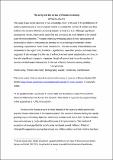Files in this item
The army and the spread of Roman citizenship
Item metadata
| dc.contributor.author | Lavan, Myles Patrick | |
| dc.date.accessioned | 2019-07-29T10:30:02Z | |
| dc.date.available | 2019-07-29T10:30:02Z | |
| dc.date.issued | 2019-11 | |
| dc.identifier | 249994570 | |
| dc.identifier | 11b6b897-4c0e-442b-b07a-b8c4f13cf0e1 | |
| dc.identifier | 85069713327 | |
| dc.identifier | 000588387900003 | |
| dc.identifier.citation | Lavan , M P 2019 , ' The army and the spread of Roman citizenship ' , Journal of Roman Studies , vol. 109 , pp. 27-69 . https://doi.org/10.1017/S0075435819000662 | en |
| dc.identifier.issn | 0075-4358 | |
| dc.identifier.other | ORCID: /0000-0001-8290-7893/work/60195929 | |
| dc.identifier.uri | https://hdl.handle.net/10023/18193 | |
| dc.description | The author acknowledges The Leverhulme Trust and the Arts and Humanities Research Council for Research Fellowships that funded this research. | en |
| dc.description.abstract | This paper draws on recent advances in our knowledge (much of it owed to the proliferation of military diplomas) and a new analytical method to quantify the number of soldiers and their children who received Roman citizenship between 14 and 212 c.e. Although significant uncertainties remain, these can be quantified and turn out to be small relative to the overall scale of enfranchisement. The paper begins by reviewing what is known about grants of citizenship to soldiers, with particular attention to the remaining uncertainties, before presenting a quantitative model of the phenomenon. The total number of beneficiaries was somewhere in the region 0.9–1.6 million — significantly lower than previous estimates have suggested. It also emerges that the rate of enfranchisement varied substantially over time, in line with significant changes in manpower, length of service (and hence the number of recruits and discharged veterans) and the rate of family formation among soldiers. The Supplementary Material available online (https://doi.org/10.1017/S0075435819000662) contains a database of military diplomas (Supplementary Appendix 1), a mathematical model of enfranchisement implemented in MS Excel (Supplementary Appendix 2), a description of the model (Supplementary Appendix 3A) and a derivation of the model of attrition across service cohorts in Fig. 6 (Supplementary Appendix 3B). | |
| dc.format.extent | 43 | |
| dc.format.extent | 1492333 | |
| dc.language.iso | eng | |
| dc.relation.ispartof | Journal of Roman Studies | en |
| dc.subject | Roman army | en |
| dc.subject | Roman citizenship | en |
| dc.subject | Demography | en |
| dc.subject | Auxilia | en |
| dc.subject | Uncertainty | en |
| dc.subject | Quantification | en |
| dc.subject | D051 Ancient History | en |
| dc.subject | T-NDAS | en |
| dc.subject | BDC | en |
| dc.subject | R2C | en |
| dc.subject.lcc | D051 | en |
| dc.title | The army and the spread of Roman citizenship | en |
| dc.type | Journal article | en |
| dc.contributor.sponsor | Arts and Humanities Research Council | en |
| dc.contributor.institution | University of St Andrews. School of Classics | en |
| dc.contributor.institution | University of St Andrews. Centre for the Literatures of the Roman Empire | en |
| dc.contributor.institution | University of St Andrews. Institute of Legal and Constitutional Research | en |
| dc.identifier.doi | 10.1017/S0075435819000662 | |
| dc.description.status | Peer reviewed | en |
| dc.date.embargoedUntil | 2019-07-24 | |
| dc.identifier.grantnumber | AH/P004571/1 | en |
This item appears in the following Collection(s)
Items in the St Andrews Research Repository are protected by copyright, with all rights reserved, unless otherwise indicated.

